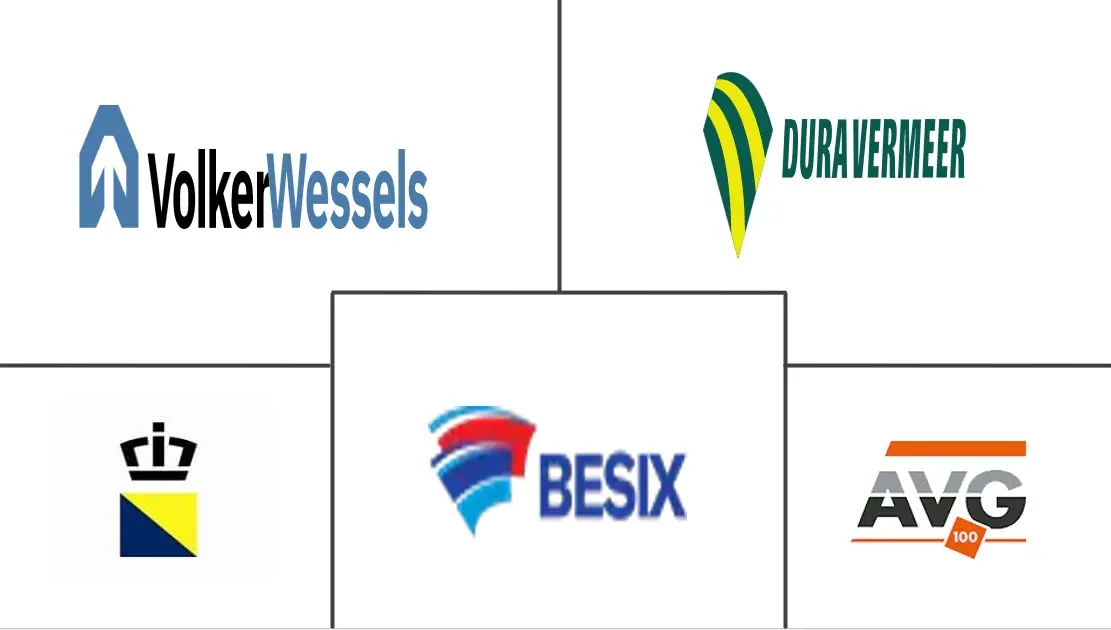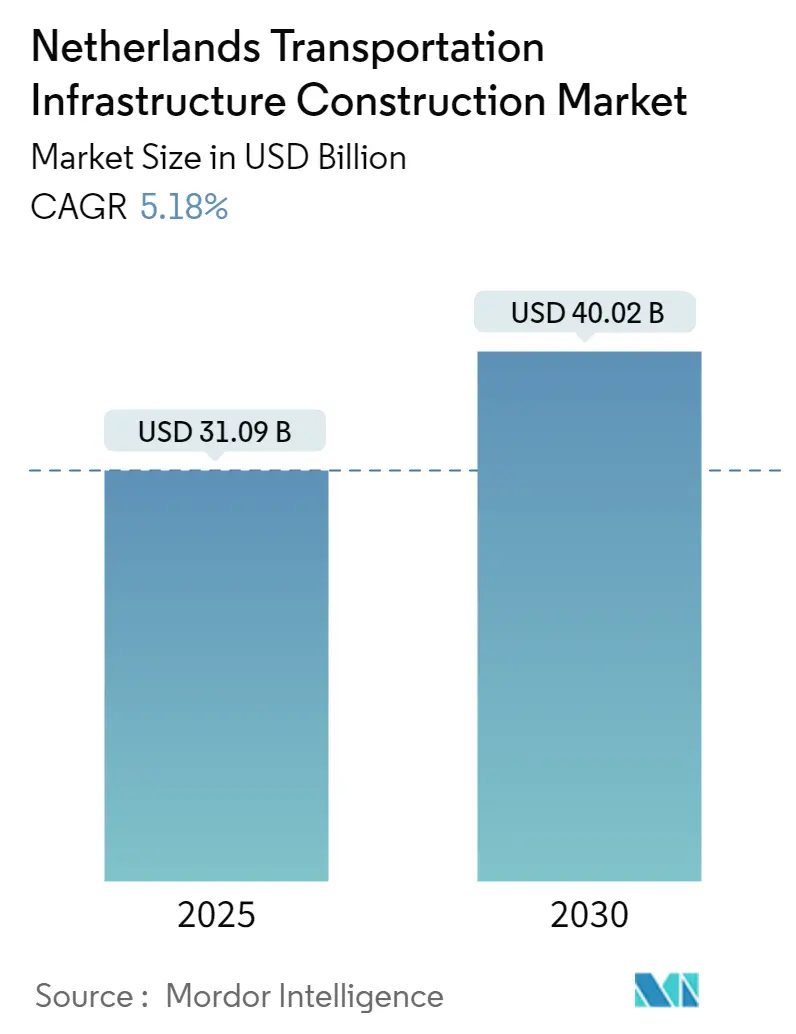
Netherlands Transportation Infrastructure Construction Market Analysis by Mordor Intelligence
The Netherlands Transportation Infrastructure Construction Market size is estimated at USD 31.09 billion in 2025, and is expected to reach USD 40.02 billion by 2030, at a CAGR of 5.18% during the forecast period (2025-2030).
- Transportation infrastructure facilitates the movement of public goods in the country. This factor results in an uninterrupted transit and freight services directly contributing to the region’s economy. Thus, governments focus on transportation infrastructure construction to support the overall development goals of the countries. The transportation infrastructure construction in Netherlands is driven by modernization, which involves reforming railways and improving and rebuilding roads, bridges, airports, etc. An increase in urban mobility in Netherlands has created a demand for the construction of more transportation projects
- COVID-19 impacted the transportation sector. The impact is in direct and indirect ways, such as a reduction in transit services, slowing down construction works due to social distancing measures, and disrupted supply chain.
- The increase in government expenditure in transportation infrastructure construction projects, along with the investments in energy-efficient and environmentally sustainable assets, is giving a boost to the Netherlands transportation infrastructure construction market. Investment in large-scale infrastructure projects is one of the key strategies of the Netherlands to promote its economic growth. The government's effort to improve the country's infrastructure will contribute to the growth in construction spending.
- Increasing public investments in Netherlands’s commercial construction sectors is a key market opportunity for the companies operating in the construction of transportation infrastructure. The presence of huge customers is resulting in strong FDI (foreign direct investment) inflows into the country.
Netherlands Transportation Infrastructure Construction Market Trends and Insights
Increasing Demand for Transportation Infrastructure
Transportation is a key factor in the growth of the economy in the Netherlands because it is a highly developed country with a very dense population. The country has a very dense and modern transportation infrastructure, facilitating transport with the road, rail, air, and water networks. The main mode of transportation for long distances in the Netherlands is train. Regional and local public transport is by bus, and in some cities by metro and tram. Randstadnet or R-net is a collaborative project of governments and public transport operators providing high-quality public transport in the Randstan area of the Netherlands. To connect the local village area of the Netherlands with the major cities like Rotterdam, The Hague, and Amsterdam, mostly trams are used. Due to the large number of waterways in the Netherlands, not every road connection has been bridged, and there are still some ferries in operation. Despite this developed transport infrastructure, the increasing mobility requirements are demanding more investment in the sector.
The government of the Netherlands is focusing on building the new transportation infrastructure as well as improving the existing infrastructure because transportation is one of the key factors contributing to the country's economy. Also, to meet the needs and demands of the dense population (17 million in 2021), more developed transportation infrastructure is needed. The Dutch government has budgeted to invest EUR 4 billion (USD 4.35 billion) in public transport infrastructure, with a particular focus on connections to new housing developments to improve their reachability. In urban regions and on busy corridors mobility is growing steadily. To address this development the government has plans. The ambition for 2040 is to offer travellers a ‘door to door’ travel time of under one hour between any of the four major cities in the Randstad region. In densely populated areas the Government wants to create a high frequency mainline network of direct connections, requiring minimal waiting times, to popular places in the major cities.
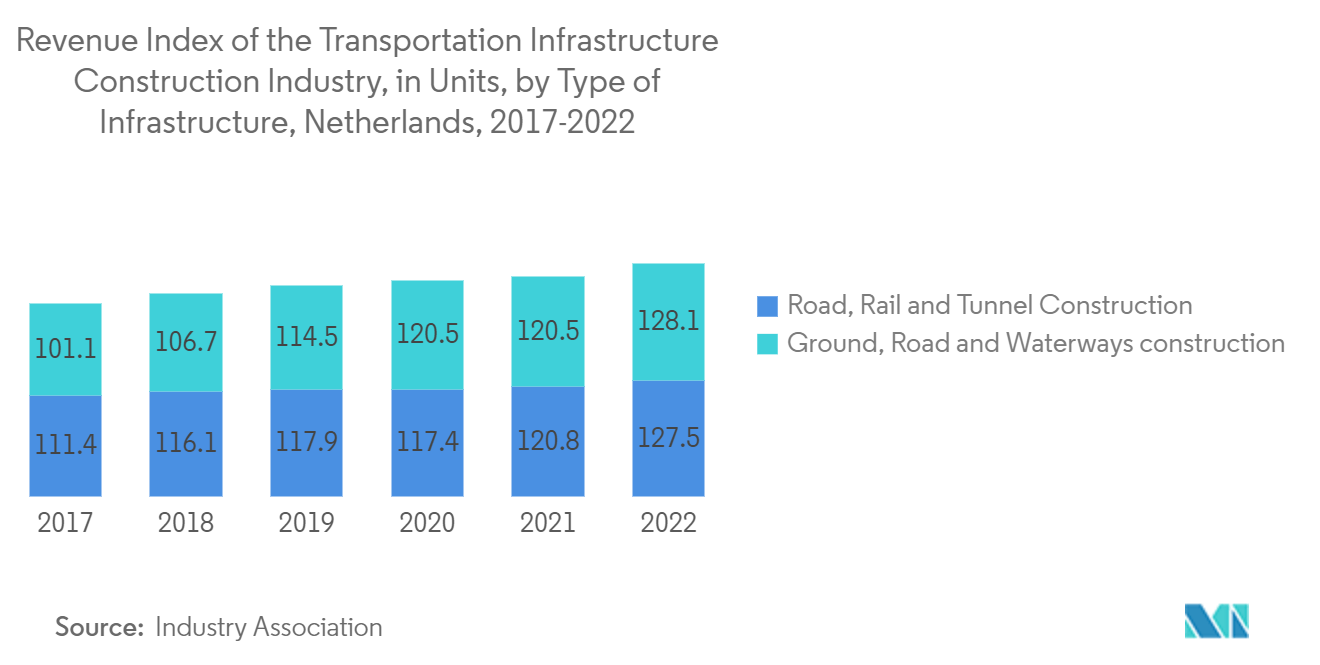
Travel and Tourism to Support the Market Growth
In the Netherlands, the travel and tourism sector has become increasingly important to the Dutch economy. The revenue from travel and tourism is expected to grow more and more every year during the forecast period. This sector is comprised of three major components: domestic, inbound, and outbound tourism. Domestic tourism, which includes Dutch citizens traveling locally within the Netherlands, reports the highest expenditure in terms of tourism expenditure in the Netherlands. In the Netherlands, most tourists are attracted to Amsterdam. Due to its historic buildings, canals, and famous museums, Amsterdam is one of the leading destination spots in the Netherlands. Not only known for its leisure tourism, but the Dutch capital is also a business travel destination, attracting thousands of global business visitors from across the world each year.
Tourism and transport infrastructure are interconnected and economically beneficial. Tourism has been known to have significant positive impacts on the development of transportation infrastructure. These include increased investment, improved access, better transportation services, improved connectivity, etc. Governments and private entities are often motivated to invest in transportation infrastructure when they anticipate increased tourist arrivals. This investment can take various forms, including the development of new airports, railway lines, highways, and public transportation systems. The tourism sector will drive the growth of transportation infrastructure construction market in Netherlands.
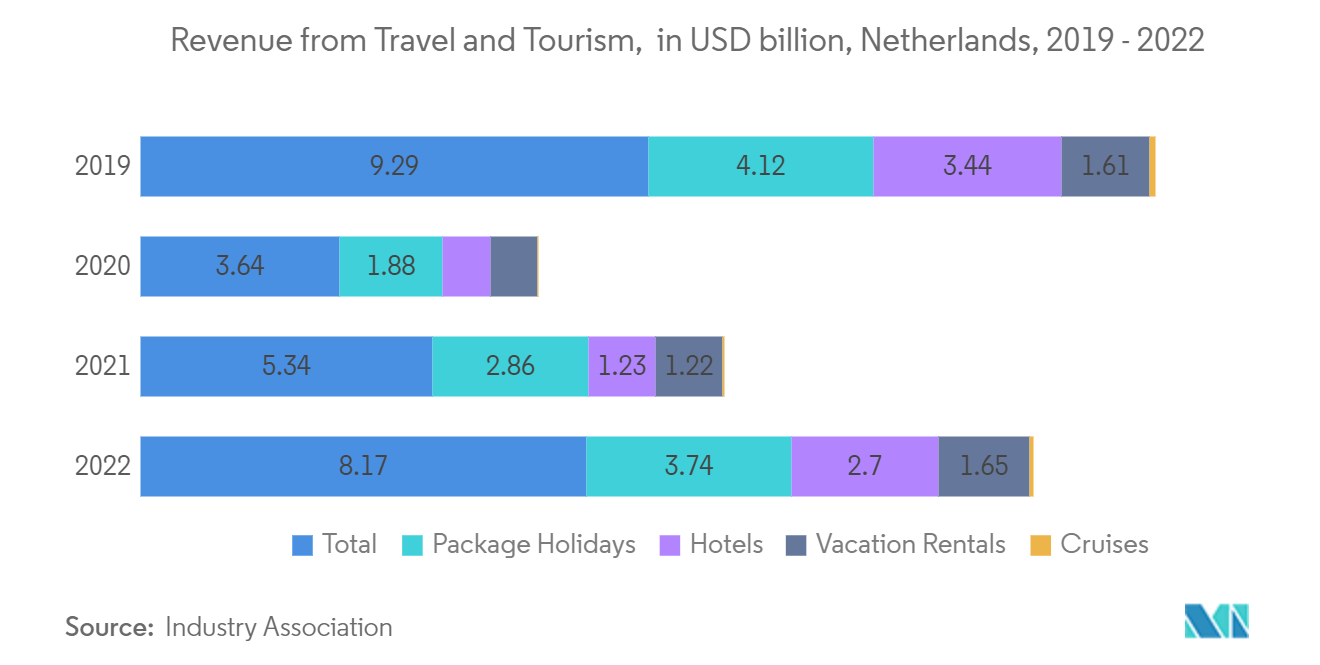
Competitive Landscape
The Netherlands Transportation Infrastructure market is fragmented in nature, with a presence of several local and international players like Royal BAM Group, Besix, Dura Vermeer, Volker Wessels, and AVG Infra. The demand for sustainability and technological advancements in the transport infrastructure market is increasing, and companies in the region are expected to adopt and remain competitive.
Netherlands Transportation Infrastructure Construction Industry Leaders
-
BESIX
-
Dura Vermeer
-
volkerWessels
-
AVG Infra
-
Royal BAM Group
-
Royal Boskalis
- *Disclaimer: Major Players sorted in no particular order
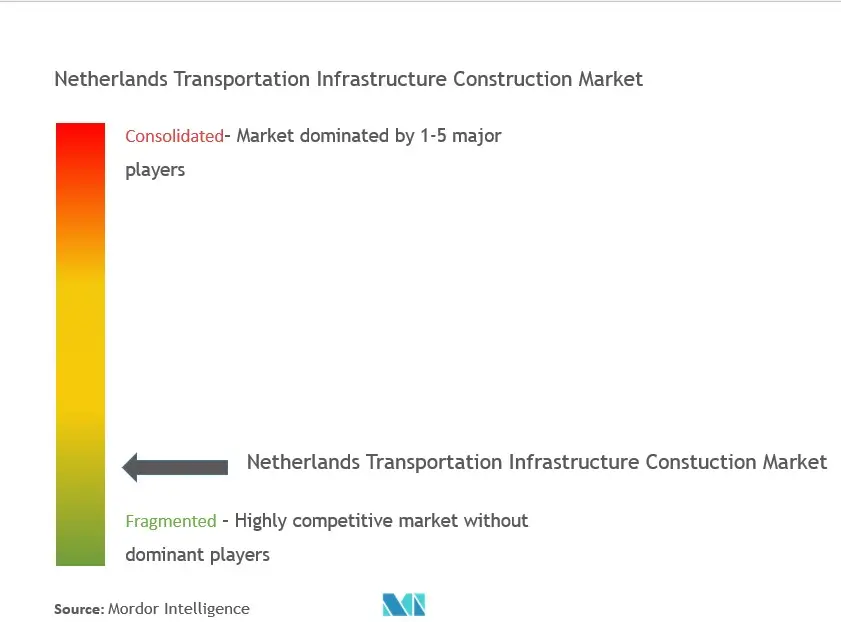
Recent Industry Developments
- September 2022: Dura Vermeer received order of one of the first three hydrogen trucks. The trucks will be used in various road construction projects in the Netherlands. The trucks refuel with hydrogen and can drive approximately 520 kilometers on a single fill-up. The hydrogen is converted into electricity in the vehicle by a so-called fuel cell. The emissions contain only water vapor and there is no air pollution by substances such as carbon monoxide, nitrogen oxides or particulate matter. One of Dura Vermeer's sustainability ambitions is "Emissions to 0". For this reason, electrical equipment is used on all projects, if available. For example, the company is working towards an emission-free construction site in 2025. The use of the new hydrogen truck is a great step in realizing this ambition.
- March 2023: The consortium De Groene Waarden, a combination between BESIX, Mobilis and partners Van Gelder, Mourik Infra and BESIX Infra Nederland, have been provisionally awarded the contract for the renewal and widening of the A27 highway between the Dutch cities Houten and Everdingen, south of Utrecht. The provisional award was made by Rijkswaterstaat, the Dutch Ministry of Infrastructure and Water Management. The stretch between Houten and Everdingen, which is 7 km long, will be widened to 4 lanes in the southern direction. In the northern direction, the two lanes and a rush-hour lane are being retained. In addition, one bridge (Hagesteinsebrug) will be renewed and another one (Houtensebrug) widened. The renewed bridge will also include a bicycle connection. The project is expected to be delivered between 2029 and 2031.
Netherlands Transportation Infrastructure Construction Market Report Scope
The transport infrastructure construction includes many activities associated with the construction of roads, railways, airports, and other related infrastructure.
The Netherlands transportation infrastructure construction market is segmented by mode (roadways, railways, airways, ports and inland waterways). The report offers market size and forecasts for Netherlands transportation infrastructure construction market in value (USD) for all the above segments.
| Roadways |
| Railways |
| Airways |
| Ports and Inland Waterways |
| By Mode | Roadways |
| Railways | |
| Airways | |
| Ports and Inland Waterways |
Key Questions Answered in the Report
How big is the Netherlands Transportation Infrastructure Construction Market?
The Netherlands Transportation Infrastructure Construction Market size is expected to reach USD 31.09 billion in 2025 and grow at a CAGR of 5.18% to reach USD 40.02 billion by 2030.
What is the current Netherlands Transportation Infrastructure Construction Market size?
In 2025, the Netherlands Transportation Infrastructure Construction Market size is expected to reach USD 31.09 billion.
Who are the key players in Netherlands Transportation Infrastructure Construction Market?
BESIX, Dura Vermeer, volkerWessels, AVG Infra, Royal BAM Group and Royal Boskalis are the major companies operating in the Netherlands Transportation Infrastructure Construction Market.
What years does this Netherlands Transportation Infrastructure Construction Market cover, and what was the market size in 2024?
In 2024, the Netherlands Transportation Infrastructure Construction Market size was estimated at USD 29.48 billion. The report covers the Netherlands Transportation Infrastructure Construction Market historical market size for years: 2020, 2021, 2022, 2023 and 2024. The report also forecasts the Netherlands Transportation Infrastructure Construction Market size for years: 2025, 2026, 2027, 2028, 2029 and 2030.
Page last updated on:
Netherlands Transportation Infrastructure Construction Market Report
Statistics for the 2025 Netherlands Transportation Infrastructure Construction market share, size and revenue growth rate, created by Mordor Intelligence™ Industry Reports. Netherlands Transportation Infrastructure Construction analysis includes a market forecast outlook for 2025 to 2030 and historical overview. Get a sample of this industry analysis as a free report PDF download.
